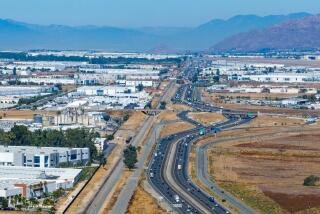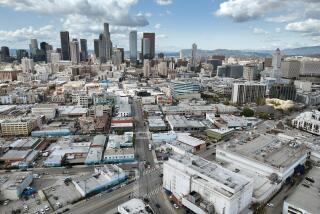Not Sure How to Pay for Land : Bellflower OKs Boundaries of Renewal Zone
- Share via
BELLFLOWER — The Bellflower City Council has tentatively approved the boundaries for its first redevelopment project, but officials are not sure how the city will pay for the land it plans to acquire.
The boundaries--Lakewood, Bellflower and Artesia boulevards--are the same that voters approved last November when they passed Proposition S.
The U-shaped redevelopment area includes the downtown business district, a variety of medium-sized commercial/industrial properties on the western edge of the city and several auto dealerships near the Artesia Freeway.
City officials said redevelopment will inject new life into an old business district, improve blighted commercial zones and keep auto dealers from relocating to other cities.
‘Will Upgrade Property’
“The main goal is to get businesses in here,” said Councilman Joseph Cvetko. “The auto malls all around us have taken our car dealers. Plus, it will upgrade the property.”
Mayor John Ansdell said many downtown businessmen have complained about the aging business district and have asked for redevelopment. He also stressed the importance of keeping auto dealers in Bellflower.
The boundaries of the redevelopment area were adopted by a 3-0 vote of the council, acting as the Community Redevelopment Agency, at a meeting July 24. Ansdell and Councilman Ken Cleveland abstained from voting since both own property in the redevelopment area, City Atty. Maurice O’Shea said. The city Planning Commission will vote on the boundaries in mid-September.
But although the Redevelopment Agency has defined the project area, it has not determined how to pay for the land.
“We don’t know how much money we will have,” City Administrator Jack Simpson said. “It doesn’t appear at this point that there will be that much money.”
Will Probably Sell Bonds
Simpson said the Redevelopment Agency will not turn to the city’s General Fund for a loan because “it is not in condition at this time to lend money.” The agency, he said, will probably sell bonds after the redevelopment plan is completed.
The Redevelopment Agency is authorized by state law to issue bonds to pay for property it buys in the project area. The agency will give the property to developers or sell it at a reduced price to encourage them to build in the city. Part of the increase in property taxes that would result from new development would be used to retire the bonds or be set aside for other projects, said Deputy City Administrator Craig Nealis.
Critics of the plan said the city may not be able to pay the bonds off with the revenues that are generated.
Ronald Price, chairman of Bellflower Citizens Concerned, an anti-redevelopment group, said the city could buy property, develop it and not be able to find tenants. “We can’t look into the future, and that could be a problem,” he said. “How much revenue will the project generate, and also how much can the city keep?”
Said Therese Kerze Cheyovich: “I’m dead set against a bond issue, because I’m worried about the debt. If you increase the debt, someone will have to pay it back 10 or 15 years down the road. I don’t think that’s smart.”
The project area contains no residentially zoned property, said Bruce Leach, assistant planner for the city. Last November, while approving Proposition S and another ballot measure lifting a ban against forming a redevelopment agency, residents also passed a measure forbidding eminent domain in residential zones, he said.
The area does contain some residential units on land with commercial or industrial zoning, Leach said. Those dwellings were built before the city’s building and property codes went into effect. But any parcel of land with four or more units on it--for example, four mobile homes or a four-unit apartment building--is excluded from the project area, he said.
Last month the council approved adding three parcels to the project area: the Artesia Freeway, a strip of land along the railroad tracks paralleling Flora Vista Street and a strip along the San Gabriel River in southeast Bellflower. David Wilcox of Economics Research Associates, a consultant to the Redevelopment Agency, said this adds 100 acres, bringing the project area to about 500 acres.
Simpson said these sections would not get a high priority for redevelopment. The area along the railroad might be developed if the tracks were abandoned, the freeway was added to make improvements such as sound barriers, and the section near the river could be upgraded for equestrian and other recreational uses, he said.
More to Read
Sign up for Essential California
The most important California stories and recommendations in your inbox every morning.
You may occasionally receive promotional content from the Los Angeles Times.













